Birthday of FM Stephen William Giddins (29-01-1961)
Here are his games from chessgames.com
We reviewed his most recent book, co-authored with IM Gerard Welling : Side-Stepping Mainline Theory
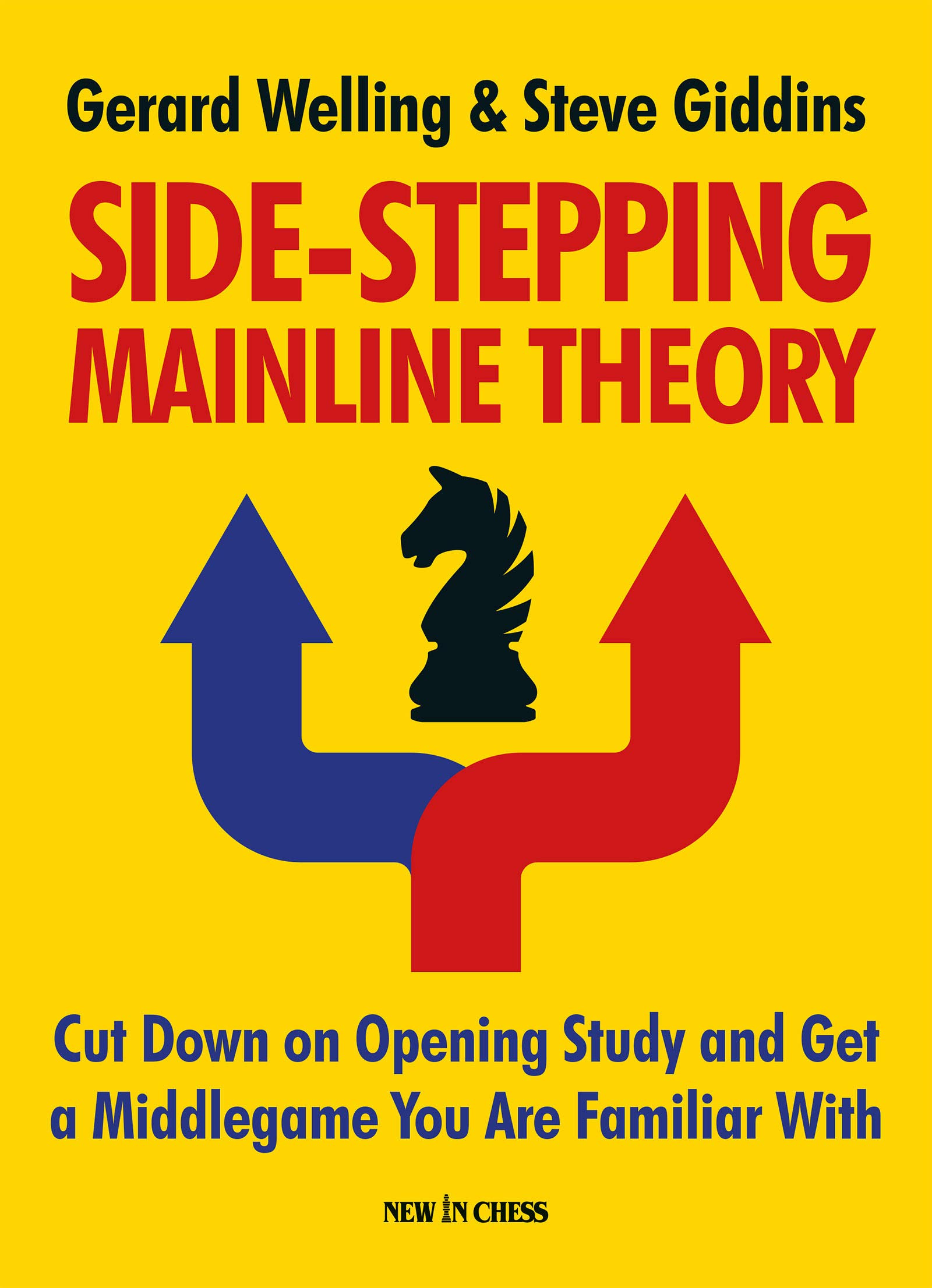
Birthday of FM Stephen William Giddins (29-01-1961)
Here are his games from chessgames.com
We reviewed his most recent book, co-authored with IM Gerard Welling : Side-Stepping Mainline Theory

Birthday of FM Stephen William Giddins (29-01-1961)
Here are his games from chessgames.com
We reviewed his most recent book, co-authored with IM Gerard Welling : Side-Stepping Mainline Theory

BCN remembers Dr. A(lfred) Christopher Reeves who passed away on Monday, December 3rd, 2012 in St. Agnes, Cornwall. His probate record (#4073868) is dated December 3rd, 2012 being recorded in the Bristol registry.
Alfred Christopher Reeves was born in Wharfedale, Yorkshire on Sunday, February 19th, 1939. His mother’s name was Tomlin.
Alfred detested his first name to the extent that he asked people to call him Christopher and, when asked, told them that the A was for Arthur. For this reason much of the chess literature uses Arthur whereas public records use Alfred.
In British Chess Magazine, Volume 133 (2013), Number 1 (January), page 2 we have this obituary from James Pratt:
“Alfred Christopher Reeves (Leeds, 19 ii 1939 – St Agnes?, 3 xii 2012). Chris Reeves was a FIDE Master of Composition. He toyed with entering the priesthood but became a child psychotherapist. He started composing (“…my solace and diversion …”) in 1960, largely specialising in the orthodox two move field. Though not a prolific composer, his work was known worldwide.
He was Sub-Editor of The Problemist”
From the The Encyclopaedia of Chess (Batsford, 1977), Harry Golombek OBE, John Rice writes:
“British problemist, output consists of skilfully constructed two-movers in the modern style.”
From The Encyclopedia of Chess (Robert Hale, 1970 & 1976), Anne Sunnucks wrote: :
“Problem composer. Since 1960 he has composed about 70 modern-style two movers, and is considered to be one of the most talented British composers. His originality and technique enable him to build into tangible form what would be no more than a passing idea for most composers. He has edited the problem section of Correspondence Chess, and he controlled BCF tourneys and International Team matches.”
From British Chess (Pergamon Press, 1983) Botterill, Levy, Rice and Richardson we have this:
“I was born on February 19th, 1939, the second son of a doctor who practised in a busy Yorkshire coal-mining town. As a youngster I acquired a taste for chess problems as soon as I learnt the moves of the game.
I owe my initiation to the admirable column which DM Davey used to run in the weekly review The Tablet and to the enterprise of one of the masters of the boarding school to which I was sent when still quite young. Davey’s column catered for novice chess problemists like myself by conducting graded solving tournaments with modest handicaps.
These tournaments ran conveniently the length of the school term, just long enough to sustain a young person’s enthusiasm, The teacher in question used to put the week’s problem up on the school noticeboard and dozens of small schoolboys participated as a result. The Tablet column was not only a boon for beginners like me. It had a very discriminating band of solvers who were given ample space to express their views on each week’s problems. This had the additional effect of making it a popular forum for budding composers who need the stimulus and encouragement of audience response in what is, after all, a very solitary sort of pastime.
My fascination with chess problems soon diverted my energies away from the game itself. I was eight when I began solving. Another 13 years elapsed before I seriously tried my hand at composing. My immediate inspiration was the example of the then young trio of British composers, Barry Barnes, Michael Lipton and John Rice. Their latest work incorporating, try-play, and often exploiting complex patterns of relationships between mates, was regarded as unacceptably, ultramodern, in some quarters but found ready appreciation with the solvers of Davey’s column.
Other sorts of problems I had enjoyed; these I wanted to emulate. The powerful attraction their work had on me has made me chary ever since of the strictures of self-appointed guardians of chess problem ‘taste’, who suggest that the modern two-mover cannot hold the same interest for the solver as the more traditional type. It certainly did not have a negative effect on me.
Problem I was one of my earliest compositions, in fact the first to gain any sort of award. At the time I was a theological student destined for the priesthood. I recall having felt some scruples about indulging in the frivolous pastime of chess problem composition not that it prevented me from becoming thoroughly addicted!
I have found that a bad conscience makes a good chess problem, and the greatest spur for composition is the feeling that one should really be busy doing something else. The problem shows a duel between the white queen and the black knight on d5, each of whose eight possible moves feature as a unique defence against one of the white queen tries. Solvers have often found the key to this problem’ quite elusive.
Problem I
The Tablet, 30th June, 1962
3rd Honorary Mention BCPS Ring Tournament
White to play and mate in 2
1.Qa1?…Nc7!
1.Qa4?…Nb6!
1.Qb1?…N5b4!
1.Qc1?…Nc3!
1.Qe1?…Ne3!
1.Qf1?…N5f4!
1.Qg4?…Nf6!
1.Qg1?…Ne7!
Key! Qb3!
The 1960s were my golden period of problem composition. They were my solace and diversion as I passed by way of theological studies through an Oxford degree to the foothills of a different career from the one I had originally envisaged, not the ‘cure of souls’ but the management and treatment of emotionally disturbed children and their families. By the end of the decade I was
already engaged in working as a Child Psychotherapist. Since then I have found that human problems have tended to displace my former involvement with problems of the chess pieces. Whereas
between 1960 and 1970 I composed seventy problems, in the subsequent decade I could manage only a dozen more. The reason for this slowing down in production, however, has not only been the demands of personal, family and professional life.
As a composer I have concentrated almost exclusively on the orthodox two-move field, one which if not yet exhausted nevertheless presents a major challenge to the composer to find something new to say or some new way of saying it. It is no accident (though I admit to a slight feeling of regret) of heterodox problems has expanded enormously in the past few years.
Of my eighty or so problems, fifty have been honoured in tournaments, ten with First prizes, ten with other prizes and the rest with Honourable Mentions and Commendations. My ambition is to
reach a respectable century of compositions, though I being to wonder whether I shall ever make the mark. I would also like to reach the FIDE Master norm for problem composition. I have
had twenty of my problems included in the triennial FIDE Albums so far, a few of them joint compositions. Here again, however, my productivity (or lack of it) may eventually tell against me.
Still, the problemist must always keep the business of honours in perspective. Composing problems is an essentially private business. Your opponent is the power of the pieces, not a fellow sitting opposite Vou. Unlike the chess player, one can keep one’s defeats to oneself when one puts the pieces away after a fruitless evening pondering over a board, so it seems only fair that
one’s successes likewise should be modestly recorded.
By a coincidence two of the three problems which I have selected to round off this brief note about myself and my compositions are ones which got no recognition from the tournament judge
at the time, although I count them amongst my best works.
I have chosen a trio of problems all roughly on the same theme, namely, the four possible moves of the pawn from its starting square. In chess problem parlance this is called the BP4M* theme when applied to the Black pawn, and the Albino theme when applied to the White pawn.
II and III show two ways in which four mates can be provided to meet each of the BP4M moves, only to be changed in the next phase of play. In II, the change is between mates set before the key and those operative after it; in III, the change is more radical, involving the transfer of the WR from one position to another, thereby creating two separate but related (or ‘twin’) problems. Incidentally, a good way to begin to get a taste of what composing involves is to take a problem like III and try to express the theme in full (here the changed BP4M) without resorting to the twinning device.
My last example, IV, shows a duel between white and black pawns, with the four Albino tries being met by the four possible BP4M defences.
(* BP4M is BCNs replacement for a word starting with p now considered by some as offensive.).
Whilst the player may rejoice in a victory soundly accomplished I can think of few pleasures to compare with the satisfaction which comes from accomplishing the sort of task which IV entails, especially when one is fairly sure that it has not been successfully achieved before. For me, at all events, this is what two-mover chess problem composition is all about: its is the ‘art if the all-but-impossible’!”
Problem II
Die Schwalbe August, 1965
White to play and mate in 2
1…dxc6+ 2. Bxc6
1…d6 2.Nd5
1…d5 2.Qb4
1…dxe6 2.Bc8
Key 1.Qxe5! (2.exd7)
1…dxc6 2.Nxc6
1…d6 2.Qf6
1…d5 2.Qc7
1…dxe6 2.Qxe6
1…Rd5+ 2.Nd5
Problem III
1st Prize
Problemist Twin Tournament 1966-67
White to play and mate in 2
Problem IV
Probleemblad, May, 1965
White to play and mate in 2
Clearly Chris was a hugely popular figure in the problem world. Here is a collection of tributes from the BCPS.
BCN remembers Dr. A(lfred) Christopher Reeves who passed away on Monday, December 3rd, 2012 in St. Agnes, Cornwall. His probate record (#4073868) is dated December 3rd, 2012 being recorded in the Bristol registry.
Alfred Christopher Reeves was born in Wharfedale, Yorkshire on Sunday, February 19th, 1939. His mother’s name was Tomlin.
Alfred detested his first name to the extent that he asked people to call him Christopher and, when asked, told them that the A was for Arthur. For this reason much of the chess literature uses Arthur whereas public records use Alfred.
In British Chess Magazine, Volume 133 (2013), Number 1 (January), page 2 we have this obituary from James Pratt:
“Alfred Christopher Reeves (Leeds, 19 ii 1939 – St Agnes?, 3 xii 2012). Chris Reeves was a FIDE Master of Composition. He toyed with entering the priesthood but became a child psychotherapist. He started composing (“…my solace and diversion …”) in 1960, largely specialising in the orthodox two move field. Though not a prolific composer, his work was known worldwide.
He was Sub-Editor of The Problemist”
From the The Encyclopaedia of Chess (Batsford, 1977), Harry Golombek OBE, John Rice writes:
“British problemist, output consists of skilfully constructed two-movers in the modern style.”
From The Encyclopedia of Chess (Robert Hale, 1970 & 1976), Anne Sunnucks wrote: :
“Problem composer. Since 1960 he has composed about 70 modern-style two movers, and is considered to be one of the most talented British composers. His originality and technique enable him to build into tangible form what would be no more than a passing idea for most composers. He has edited the problem section of Correspondence Chess, and he controlled BCF tourneys and International Team matches.”
From British Chess (Pergamon Press, 1983) Botterill, Levy, Rice and Richardson we have this:
“I was born on February 19th, 1939, the second son of a doctor who practised in a busy Yorkshire coal-mining town. As a youngster I acquired a taste for chess problems as soon as I learnt the moves of the game.
I owe my initiation to the admirable column which DM Davey used to run in the weekly review The Tablet and to the enterprise of one of the masters of the boarding school to which I was sent when still quite young. Davey’s column catered for novice chess problemists like myself by conducting graded solving tournaments with modest handicaps.
These tournaments ran conveniently the length of the school term, just long enough to sustain a young person’s enthusiasm, The teacher in question used to put the week’s problem up on the school noticeboard and dozens of small schoolboys participated as a result. The Tablet column was not only a boon for beginners like me. It had a very discriminating band of solvers who were given ample space to express their views on each week’s problems. This had the additional effect of making it a popular forum for budding composers who need the stimulus and encouragement of audience response in what is, after all, a very solitary sort of pastime.
My fascination with chess problems soon diverted my energies away from the game itself. I was eight when I began solving. Another 13 years elapsed before I seriously tried my hand at composing. My immediate inspiration was the example of the then young trio of British composers, Barry Barnes, Michael Lipton and John Rice. Their latest work incorporating, try-play, and often exploiting complex patterns of relationships between mates, was regarded as unacceptably, ultramodern, in some quarters but found ready appreciation with the solvers of Davey’s column.
Other sorts of problems I had enjoyed; these I wanted to emulate. The powerful attraction their work had on me has made me chary ever since of the strictures of self-appointed guardians of chess problem ‘taste’, who suggest that the modern two-mover cannot hold the same interest for the solver as the more traditional type. It certainly did not have a negative effect on me.
Problem I was one of my earliest compositions, in fact the first to gain any sort of award. At the time I was a theological student destined for the priesthood. I recall having felt some scruples about indulging in the frivolous pastime of chess problem composition not that it prevented me from becoming thoroughly addicted!
I have found that a bad conscience makes a good chess problem, and the greatest spur for composition is the feeling that one should really be busy doing something else. The problem shows a duel between the white queen and the black knight on d5, each of whose eight possible moves feature as a unique defence against one of the white queen tries. Solvers have often found the key to this problem’ quite elusive.
Problem I
The Tablet, 30th June, 1962
3rd Honorary Mention BCPS Ring Tournament
White to play and mate in 2
1.Qa1?…Nc7!
1.Qa4?…Nb6!
1.Qb1?…N5b4!
1.Qc1?…Nc3!
1.Qe1?…Ne3!
1.Qf1?…N5f4!
1.Qg4?…Nf6!
1.Qg1?…Ne7!
Key! Qb3!
The 1960s were my golden period of problem composition. They were my solace and diversion as I passed by way of theological studies through an Oxford degree to the foothills of a different career from the one I had originally envisaged, not the ‘cure of souls’ but the management and treatment of emotionally disturbed children and their families. By the end of the decade I was
already engaged in working as a Child Psychotherapist. Since then I have found that human problems have tended to displace my former involvement with problems of the chess pieces. Whereas
between 1960 and 1970 I composed seventy problems, in the subsequent decade I could manage only a dozen more. The reason for this slowing down in production, however, has not only been the demands of personal, family and professional life.
As a composer I have concentrated almost exclusively on the orthodox two-move field, one which if not yet exhausted nevertheless presents a major challenge to the composer to find something new to say or some new way of saying it. It is no accident (though I admit to a slight feeling of regret) of heterodox problems has expanded enormously in the past few years.
Of my eighty or so problems, fifty have been honoured in tournaments, ten with First prizes, ten with other prizes and the rest with Honourable Mentions and Commendations. My ambition is to
reach a respectable century of compositions, though I being to wonder whether I shall ever make the mark. I would also like to reach the FIDE Master norm for problem composition. I have
had twenty of my problems included in the triennial FIDE Albums so far, a few of them joint compositions. Here again, however, my productivity (or lack of it) may eventually tell against me.
Still, the problemist must always keep the business of honours in perspective. Composing problems is an essentially private business. Your opponent is the power of the pieces, not a fellow sitting opposite Vou. Unlike the chess player, one can keep one’s defeats to oneself when one puts the pieces away after a fruitless evening pondering over a board, so it seems only fair that
one’s successes likewise should be modestly recorded.
By a coincidence two of the three problems which I have selected to round off this brief note about myself and my compositions are ones which got no recognition from the tournament judge
at the time, although I count them amongst my best works.
I have chosen a trio of problems all roughly on the same theme, namely, the four possible moves of the pawn from its starting square. In chess problem parlance this is called the BP4M* theme when applied to the Black pawn, and the Albino theme when applied to the White pawn.
II and III show two ways in which four mates can be provided to meet each of the BP4M moves, only to be changed in the next phase of play. In II, the change is between mates set before the key and those operative after it; in III, the change is more radical, involving the transfer of the WR from one position to another, thereby creating two separate but related (or ‘twin’) problems. Incidentally, a good way to begin to get a taste of what composing involves is to take a problem like III and try to express the theme in full (here the changed BP4M) without resorting to the twinning device.
My last example, IV, shows a duel between white and black pawns, with the four Albino tries being met by the four possible BP4M defences.
(* BP4M is BCNs replacement for a word starting with p now considered by some as offensive.).
Whilst the player may rejoice in a victory soundly accomplished I can think of few pleasures to compare with the satisfaction which comes from accomplishing the sort of task which IV entails, especially when one is fairly sure that it has not been successfully achieved before. For me, at all events, this is what two-mover chess problem composition is all about: its is the ‘art if the all-but-impossible’!”
Problem II
Die Schwalbe August, 1965
White to play and mate in 2
1…dxc6+ 2. Bxc6
1…d6 2.Nd5
1…d5 2.Qb4
1…dxe6 2.Bc8
Key 1.Qxe5! (2.exd7)
1…dxc6 2.Nxc6
1…d6 2.Qf6
1…d5 2.Qc7
1…dxe6 2.Qxe6
1…Rd5+ 2.Nd5
Problem III
1st Prize
Problemist Twin Tournament 1966-67
White to play and mate in 2
Problem IV
Probleemblad, May, 1965
White to play and mate in 2
Clearly Chris was a hugely popular figure in the problem world. Here is a collection of tributes from the BCPS.
BCN remembers Dr. A(lfred) Christopher Reeves who passed away on Monday, December 3rd, 2012 in St. Agnes, Cornwall. His probate record (#4073868) is dated December 3rd, 2012 being recorded in the Bristol registry.
Alfred Christopher Reeves was born in Wharfedale, Yorkshire on Sunday, February 19th, 1939. His mother’s name was Tomlin.
Alfred detested his first name to the extent that he asked people to call him Christopher and, when asked, told them that the A was for Arthur. For this reason much of the chess literature uses Arthur whereas public records use Alfred.
In British Chess Magazine, Volume 133 (2013), Number 1 (January), page 2 we have this obituary from James Pratt:
“Alfred Christopher Reeves (Leeds, 19 ii 1939 – St Agnes?, 3 xii 2012). Chris Reeves was a FIDE Master of Composition. He toyed with entering the priesthood but became a child psychotherapist. He started composing (“…my solace and diversion …”) in 1960, largely specialising in the orthodox two move field. Though not a prolific composer, his work was known worldwide.
He was Sub-Editor of The Problemist”
From the The Encyclopaedia of Chess (Batsford, 1977), Harry Golombek OBE, John Rice writes:
“British problemist, output consists of skilfully constructed two-movers in the modern style.”
From The Encyclopedia of Chess (Robert Hale, 1970 & 1976), Anne Sunnucks wrote: :
“Problem composer. Since 1960 he has composed about 70 modern-style two movers, and is considered to be one of the most talented British composers. His originality and technique enable him to build into tangible form what would be no more than a passing idea for most composers. He has edited the problem section of Correspondence Chess, and he controlled BCF tourneys and International Team matches.”
From British Chess (Pergamon Press, 1983) Botterill, Levy, Rice and Richardson we have this:
“I was born on February 19th, 1939, the second son of a doctor who practised in a busy Yorkshire coal-mining town. As a youngster I acquired a taste for chess problems as soon as I learnt the moves of the game.
I owe my initiation to the admirable column which DM Davey used to run in the weekly review The Tablet and to the enterprise of one of the masters of the boarding school to which I was sent when still quite young. Davey’s column catered for novice chess problemists like myself by conducting graded solving tournaments with modest handicaps.
These tournaments ran conveniently the length of the school term, just long enough to sustain a young person’s enthusiasm, The teacher in question used to put the week’s problem up on the school noticeboard and dozens of small schoolboys participated as a result. The Tablet column was not only a boon for beginners like me. It had a very discriminating band of solvers who were given ample space to express their views on each week’s problems. This had the additional effect of making it a popular forum for budding composers who need the stimulus and encouragement of audience response in what is, after all, a very solitary sort of pastime.
My fascination with chess problems soon diverted my energies away from the game itself. I was eight when I began solving. Another 13 years elapsed before I seriously tried my hand at composing. My immediate inspiration was the example of the then young trio of British composers, Barry Barnes, Michael Lipton and John Rice. Their latest work incorporating, try-play, and often exploiting complex patterns of relationships between mates, was regarded as unacceptably, ultramodern, in some quarters but found ready appreciation with the solvers of Davey’s column.
Other sorts of problems I had enjoyed; these I wanted to emulate. The powerful attraction their work had on me has made me chary ever since of the strictures of self-appointed guardians of chess problem ‘taste’, who suggest that the modern two-mover cannot hold the same interest for the solver as the more traditional type. It certainly did not have a negative effect on me.
Problem I was one of my earliest compositions, in fact the first to gain any sort of award. At the time I was a theological student destined for the priesthood. I recall having felt some scruples about indulging in the frivolous pastime of chess problem composition not that it prevented me from becoming thoroughly addicted!
I have found that a bad conscience makes a good chess problem, and the greatest spur for composition is the feeling that one should really be busy doing something else. The problem shows a duel between the white queen and the black knight on d5, each of whose eight possible moves feature as a unique defence against one of the white queen tries. Solvers have often found the key to this problem’ quite elusive.
Problem I
The Tablet, 30th June, 1962
3rd Honorary Mention BCPS Ring Tournament
White to play and mate in 2
1.Qa1?…Nc7!
1.Qa4?…Nb6!
1.Qb1?…N5b4!
1.Qc1?…Nc3!
1.Qe1?…Ne3!
1.Qf1?…N5f4!
1.Qg4?…Nf6!
1.Qg1?…Ne7!
Key! Qb3!
The 1960s were my golden period of problem composition. They were my solace and diversion as I passed by way of theological studies through an Oxford degree to the foothills of a different career from the one I had originally envisaged, not the ‘cure of souls’ but the management and treatment of emotionally disturbed children and their families. By the end of the decade I was
already engaged in working as a Child Psychotherapist. Since then I have found that human problems have tended to displace my former involvement with problems of the chess pieces. Whereas
between 1960 and 1970 I composed seventy problems, in the subsequent decade I could manage only a dozen more. The reason for this slowing down in production, however, has not only been the demands of personal, family and professional life.
As a composer I have concentrated almost exclusively on the orthodox two-move field, one which if not yet exhausted nevertheless presents a major challenge to the composer to find something new to say or some new way of saying it. It is no accident (though I admit to a slight feeling of regret) of heterodox problems has expanded enormously in the past few years.
Of my eighty or so problems, fifty have been honoured in tournaments, ten with First prizes, ten with other prizes and the rest with Honourable Mentions and Commendations. My ambition is to
reach a respectable century of compositions, though I being to wonder whether I shall ever make the mark. I would also like to reach the FIDE Master norm for problem composition. I have
had twenty of my problems included in the triennial FIDE Albums so far, a few of them joint compositions. Here again, however, my productivity (or lack of it) may eventually tell against me.
Still, the problemist must always keep the business of honours in perspective. Composing problems is an essentially private business. Your opponent is the power of the pieces, not a fellow sitting opposite Vou. Unlike the chess player, one can keep one’s defeats to oneself when one puts the pieces away after a fruitless evening pondering over a board, so it seems only fair that
one’s successes likewise should be modestly recorded.
By a coincidence two of the three problems which I have selected to round off this brief note about myself and my compositions are ones which got no recognition from the tournament judge
at the time, although I count them amongst my best works.
I have chosen a trio of problems all roughly on the same theme, namely, the four possible moves of the pawn from its starting square. In chess problem parlance this is called the BP4M* theme when applied to the Black pawn, and the Albino theme when applied to the White pawn.
II and III show two ways in which four mates can be provided to meet each of the BP4M moves, only to be changed in the next phase of play. In II, the change is between mates set before the key and those operative after it; in III, the change is more radical, involving the transfer of the WR from one position to another, thereby creating two separate but related (or ‘twin’) problems. Incidentally, a good way to begin to get a taste of what composing involves is to take a problem like III and try to express the theme in full (here the changed BP4M) without resorting to the twinning device.
My last example, IV, shows a duel between white and black pawns, with the four Albino tries being met by the four possible BP4M defences.
(* BP4M is BCNs replacement for a word starting with p now considered by some as offensive.).
Whilst the player may rejoice in a victory soundly accomplished I can think of few pleasures to compare with the satisfaction which comes from accomplishing the sort of task which IV entails, especially when one is fairly sure that it has not been successfully achieved before. For me, at all events, this is what two-mover chess problem composition is all about: its is the ‘art if the all-but-impossible’!”
Problem II
Die Schwalbe August, 1965
White to play and mate in 2
1…dxc6+ 2. Bxc6
1…d6 2.Nd5
1…d5 2.Qb4
1…dxe6 2.Bc8
Key 1.Qxe5! (2.exd7)
1…dxc6 2.Nxc6
1…d6 2.Qf6
1…d5 2.Qc7
1…dxe6 2.Qxe6
1…Rd5+ 2.Nd5
Problem III
1st Prize
Problemist Twin Tournament 1966-67
White to play and mate in 2
Problem IV
Probleemblad, May, 1965
White to play and mate in 2
Clearly Chris was a hugely popular figure in the problem world. Here is a collection of tributes from the BCPS.
BCN remembers Dr. A(lfred) Christopher Reeves who passed away on Monday, December 3rd, 2012 in St. Agnes, Cornwall. His probate record (#4073868) is dated December 3rd, 2012 being recorded in the Bristol registry.
Alfred Christopher Reeves was born in Wharfedale, Yorkshire on Sunday, February 19th, 1939. His mother’s name was Tomlin.
Alfred detested his first name to the extent that he asked people to call him Christopher and, when asked, told them that the A was for Arthur. For this reason much of the chess literature uses Arthur whereas public records use Alfred.
In British Chess Magazine, Volume 133 (2013), Number 1 (January), page 2 we have this obituary from James Pratt:
“Alfred Christopher Reeves (Leeds, 19 ii 1939 – St Agnes?, 3 xii 2012). Chris Reeves was a FIDE Master of Composition. He toyed with entering the priesthood but became a child psychotherapist. He started composing (“…my solace and diversion …”) in 1960, largely specialising in the orthodox two move field. Though not a prolific composer, his work was known worldwide.
He was Sub-Editor of The Problemist”
From the The Encyclopaedia of Chess (Batsford, 1977), Harry Golombek OBE, John Rice writes:
“British problemist, output consists of skilfully constructed two-movers in the modern style.”
From The Encyclopedia of Chess (Robert Hale, 1970 & 1976), Anne Sunnucks wrote: :
“Problem composer. Since 1960 he has composed about 70 modern-style two movers, and is considered to be one of the most talented British composers. His originality and technique enable him to build into tangible form what would be no more than a passing idea for most composers. He has edited the problem section of Correspondence Chess, and he controlled BCF tourneys and International Team matches.”
From British Chess (Pergamon Press, 1983) Botterill, Levy, Rice and Richardson we have this:
“I was born on February 19th, 1939, the second son of a doctor who practised in a busy Yorkshire coal-mining town. As a youngster I acquired a taste for chess problems as soon as I learnt the moves of the game.
I owe my initiation to the admirable column which DM Davey used to run in the weekly review The Tablet and to the enterprise of one of the masters of the boarding school to which I was sent when still quite young. Davey’s column catered for novice chess problemists like myself by conducting graded solving tournaments with modest handicaps.
These tournaments ran conveniently the length of the school term, just long enough to sustain a young person’s enthusiasm, The teacher in question used to put the week’s problem up on the school noticeboard and dozens of small schoolboys participated as a result. The Tablet column was not only a boon for beginners like me. It had a very discriminating band of solvers who were given ample space to express their views on each week’s problems. This had the additional effect of making it a popular forum for budding composers who need the stimulus and encouragement of audience response in what is, after all, a very solitary sort of pastime.
My fascination with chess problems soon diverted my energies away from the game itself. I was eight when I began solving. Another 13 years elapsed before I seriously tried my hand at composing. My immediate inspiration was the example of the then young trio of British composers, Barry Barnes, Michael Lipton and John Rice. Their latest work incorporating, try-play, and often exploiting complex patterns of relationships between mates, was regarded as unacceptably, ultramodern, in some quarters but found ready appreciation with the solvers of Davey’s column.
Other sorts of problems I had enjoyed; these I wanted to emulate. The powerful attraction their work had on me has made me chary ever since of the strictures of self-appointed guardians of chess problem ‘taste’, who suggest that the modern two-mover cannot hold the same interest for the solver as the more traditional type. It certainly did not have a negative effect on me.
Problem I was one of my earliest compositions, in fact the first to gain any sort of award. At the time I was a theological student destined for the priesthood. I recall having felt some scruples about indulging in the frivolous pastime of chess problem composition not that it prevented me from becoming thoroughly addicted!
I have found that a bad conscience makes a good chess problem, and the greatest spur for composition is the feeling that one should really be busy doing something else. The problem shows a duel between the white queen and the black knight on d5, each of whose eight possible moves feature as a unique defence against one of the white queen tries. Solvers have often found the key to this problem’ quite elusive.
Problem I
The Tablet, 30th June, 1962
3rd Honorary Mention BCPS Ring Tournament
White to play and mate in 2
1.Qa1?…Nc7!
1.Qa4?…Nb6!
1.Qb1?…N5b4!
1.Qc1?…Nc3!
1.Qe1?…Ne3!
1.Qf1?…N5f4!
1.Qg4?…Nf6!
1.Qg1?…Ne7!
Key! Qb3!
The 1960s were my golden period of problem composition. They were my solace and diversion as I passed by way of theological studies through an Oxford degree to the foothills of a different career from the one I had originally envisaged, not the ‘cure of souls’ but the management and treatment of emotionally disturbed children and their families. By the end of the decade I was
already engaged in working as a Child Psychotherapist. Since then I have found that human problems have tended to displace my former involvement with problems of the chess pieces. Whereas
between 1960 and 1970 I composed seventy problems, in the subsequent decade I could manage only a dozen more. The reason for this slowing down in production, however, has not only been the demands of personal, family and professional life.
As a composer I have concentrated almost exclusively on the orthodox two-move field, one which if not yet exhausted nevertheless presents a major challenge to the composer to find something new to say or some new way of saying it. It is no accident (though I admit to a slight feeling of regret) of heterodox problems has expanded enormously in the past few years.
Of my eighty or so problems, fifty have been honoured in tournaments, ten with First prizes, ten with other prizes and the rest with Honourable Mentions and Commendations. My ambition is to
reach a respectable century of compositions, though I being to wonder whether I shall ever make the mark. I would also like to reach the FIDE Master norm for problem composition. I have
had twenty of my problems included in the triennial FIDE Albums so far, a few of them joint compositions. Here again, however, my productivity (or lack of it) may eventually tell against me.
Still, the problemist must always keep the business of honours in perspective. Composing problems is an essentially private business. Your opponent is the power of the pieces, not a fellow sitting opposite Vou. Unlike the chess player, one can keep one’s defeats to oneself when one puts the pieces away after a fruitless evening pondering over a board, so it seems only fair that
one’s successes likewise should be modestly recorded.
By a coincidence two of the three problems which I have selected to round off this brief note about myself and my compositions are ones which got no recognition from the tournament judge
at the time, although I count them amongst my best works.
I have chosen a trio of problems all roughly on the same theme, namely, the four possible moves of the pawn from its starting square. In chess problem parlance this is called the BP4M* theme when applied to the Black pawn, and the Albino theme when applied to the White pawn.
II and III show two ways in which four mates can be provided to meet each of the BP4M moves, only to be changed in the next phase of play. In II, the change is between mates set before the key and those operative after it; in III, the change is more radical, involving the transfer of the WR from one position to another, thereby creating two separate but related (or ‘twin’) problems. Incidentally, a good way to begin to get a taste of what composing involves is to take a problem like III and try to express the theme in full (here the changed BP4M) without resorting to the twinning device.
My last example, IV, shows a duel between white and black pawns, with the four Albino tries being met by the four possible BP4M defences.
(* BP4M is BCNs replacement for a word starting with p now considered by some as offensive.).
Whilst the player may rejoice in a victory soundly accomplished I can think of few pleasures to compare with the satisfaction which comes from accomplishing the sort of task which IV entails, especially when one is fairly sure that it has not been successfully achieved before. For me, at all events, this is what two-mover chess problem composition is all about: its is the ‘art if the all-but-impossible’!”
Problem II
Die Schwalbe August, 1965
White to play and mate in 2
1…dxc6+ 2. Bxc6
1…d6 2.Nd5
1…d5 2.Qb4
1…dxe6 2.Bc8
Key 1.Qxe5! (2.exd7)
1…dxc6 2.Nxc6
1…d6 2.Qf6
1…d5 2.Qc7
1…dxe6 2.Qxe6
1…Rd5+ 2.Nd5
Problem III
1st Prize
Problemist Twin Tournament 1966-67
White to play and mate in 2
Problem IV
Probleemblad, May, 1965
White to play and mate in 2
Clearly Chris was a hugely popular figure in the problem world. Here is a collection of tributes from the BCPS.
BCN wishes Happy Birthday to GM Daniel Fernandez who at 26 is currently England’s youngest Grandmaster. The previous GM title holder was Jonathan Hawkins in 2014 making two in seven years.
Daniel Howard Fernandez was born in Stockport, Manchester on Sunday, March 5th 1995. “Think Twice” by Celine Dion was top of the UK hit parade.
Daniel started playing chess at the age of seven (after his father taught him the rules) and at this time attended King’s School, Harpenden. His first chess club was Little Heath which became the ECF Small Club of the Year in 2015. They play in the Potter’s Bar area and include IM John Pigott in their membership.
At Little Heath Chess Club Daniel was coached by Mark Uniacke (who worked extensively on the early chess engine HIARCS).
Daniel went up to Queen’s College, Cambridge to read mathematics and left to become a Data Analyst at Mu Sigma Inc. He can speak several languages (including Serbian!) and works as a translator when opportunities arise.
He currently lives in Australia offering coaching and writing chess books (for Thinkers Publishing) and columns for Chessbase. In his spare time (!) Daniel is studying for The Master of Complex Systems degree at The University of Sydney.
Daniel’s first ECF graded game was rapidplay on July 5th 2003 in the SCCU Junior Under-14 Final.
His first standard play game was in August 2003 at the Edinburgh based British Under-8 Championship.

Daniels ECF grading profile demonstrated rapid improvement :
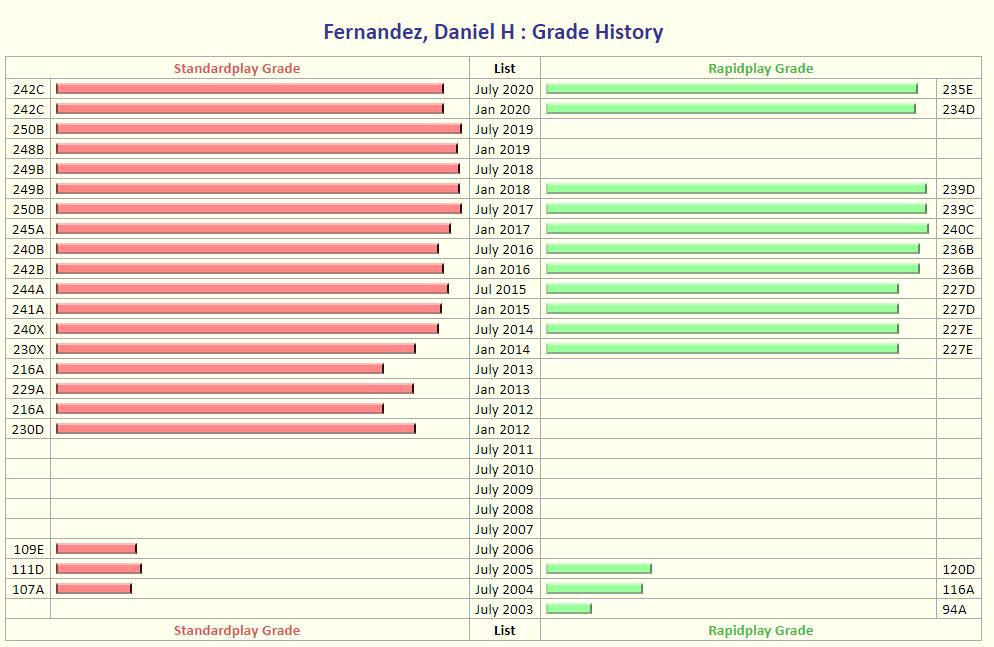
On August 13th 2004 in Scarborough Daniel became British Under-9 Champion sharing the title with Daniel Hunt & Saravanan Sathyanandha.
The Fernandez family relocated to Singapore in August, Daniel attending the Anglo-Chinese School in Singapore. He was swiftly recruited into the Singapore Chess Federation’s (SCF) National Junior Squad. Also in that squad were Danielle Ho and Howard Chiu (remember this for later!).
Barely three weeks after his Scarborough triumph on September 4th 2004 Daniel played his first FIDE rated game in the 5th Asian Under-10 Championship organised by the ASEAN Chess Confederation. His performance in this event was rewarded with a FIDE Master title in 2005. Because he was no longer active in English events the ECF had the unusual scenario of having a ten year old FIDE Master with a published grade of ~120!
In typically modest fashion Daniel confesses that he did not “deserve” the FM title at this time and that it was the consequence of the strong position of the ASEAN and SCF organisations within world chess. At the same event Wesley So gained his FM title in the Under-12 section.

Another interesting consequence of the relocation was that when Daniel returned to England in 2012 his last published grading went from ~ 120 to ~230!
One of the motivations of returning to England was to obtain the necessary entrance requirement to study mathematics at Cambridge. This he did by studying for A-levels at Manchester Grammar School.
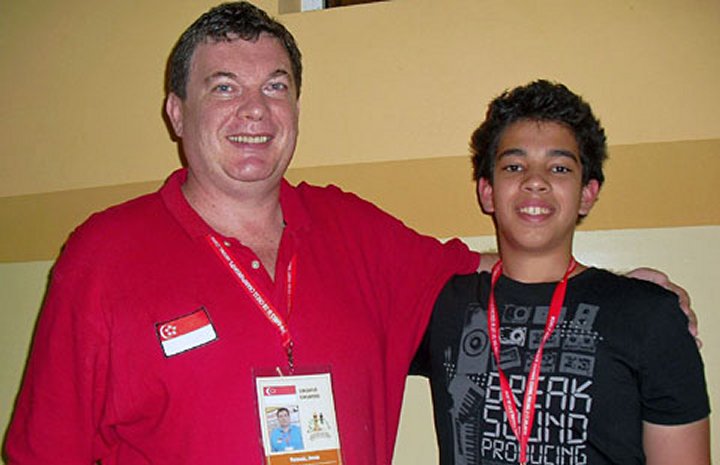
Consequently Daniel’s FIDE rating profile also showed a fast pace of development:
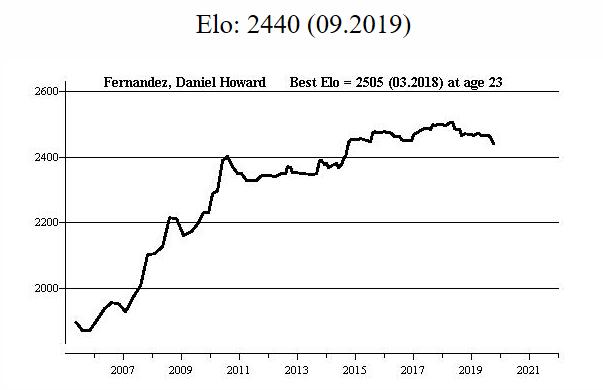
Sydney 2009 and Sydney 2010 both provided IM norms with the third one coming from Kuala Lumpar 2010 and with these Daniel became an International Master in 2010 the title being confirmed at the 3rd quarter Presidential Board Meeting 2010, 24-25 July 2010, Tromso in Norway.
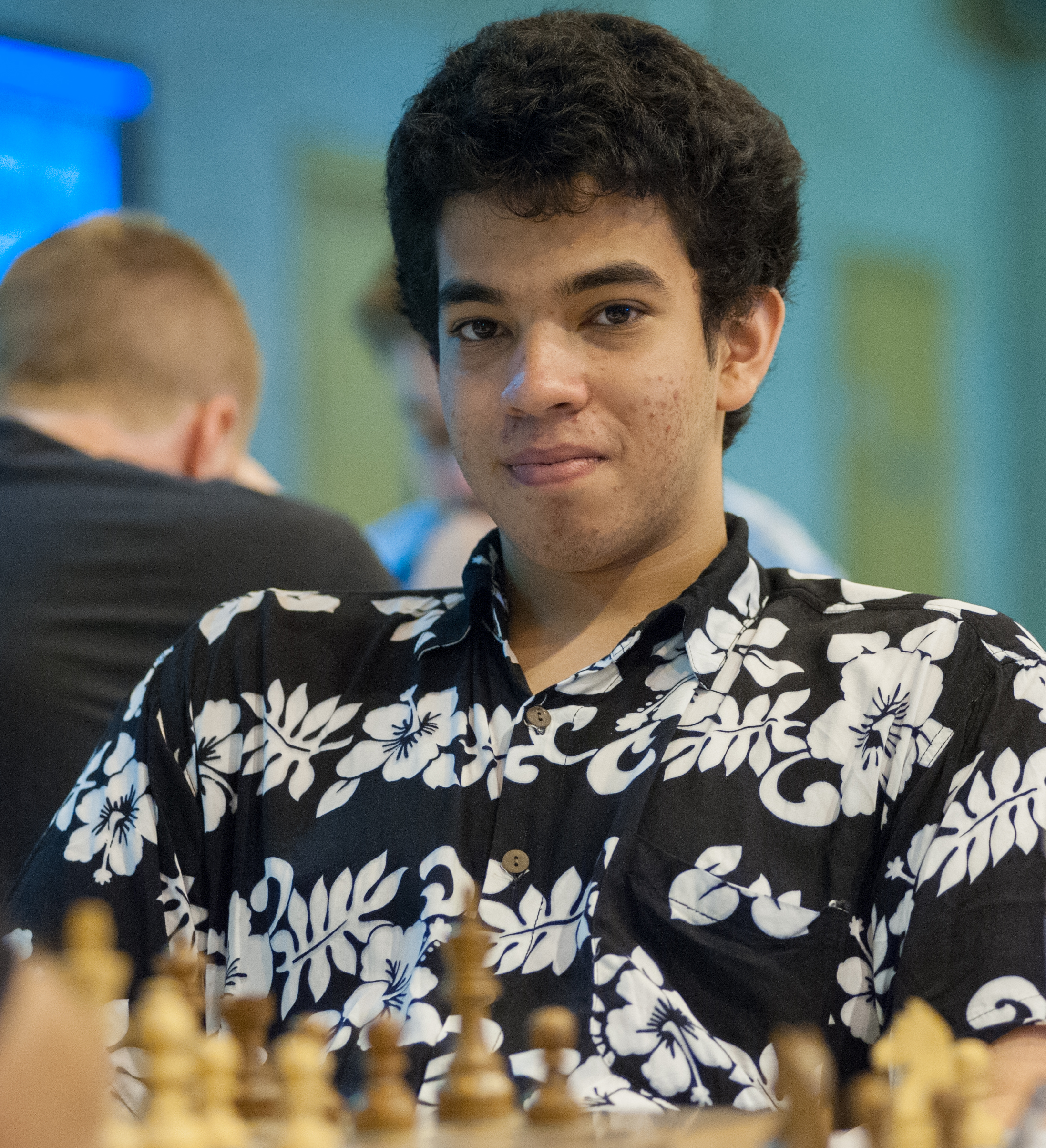
He won the Budapest Sarkany Tournament in 2014 as follows:
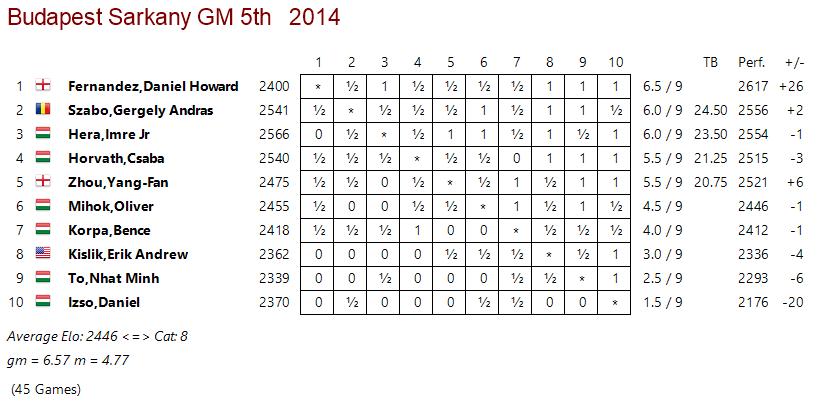
earning his first GM norm in the process.
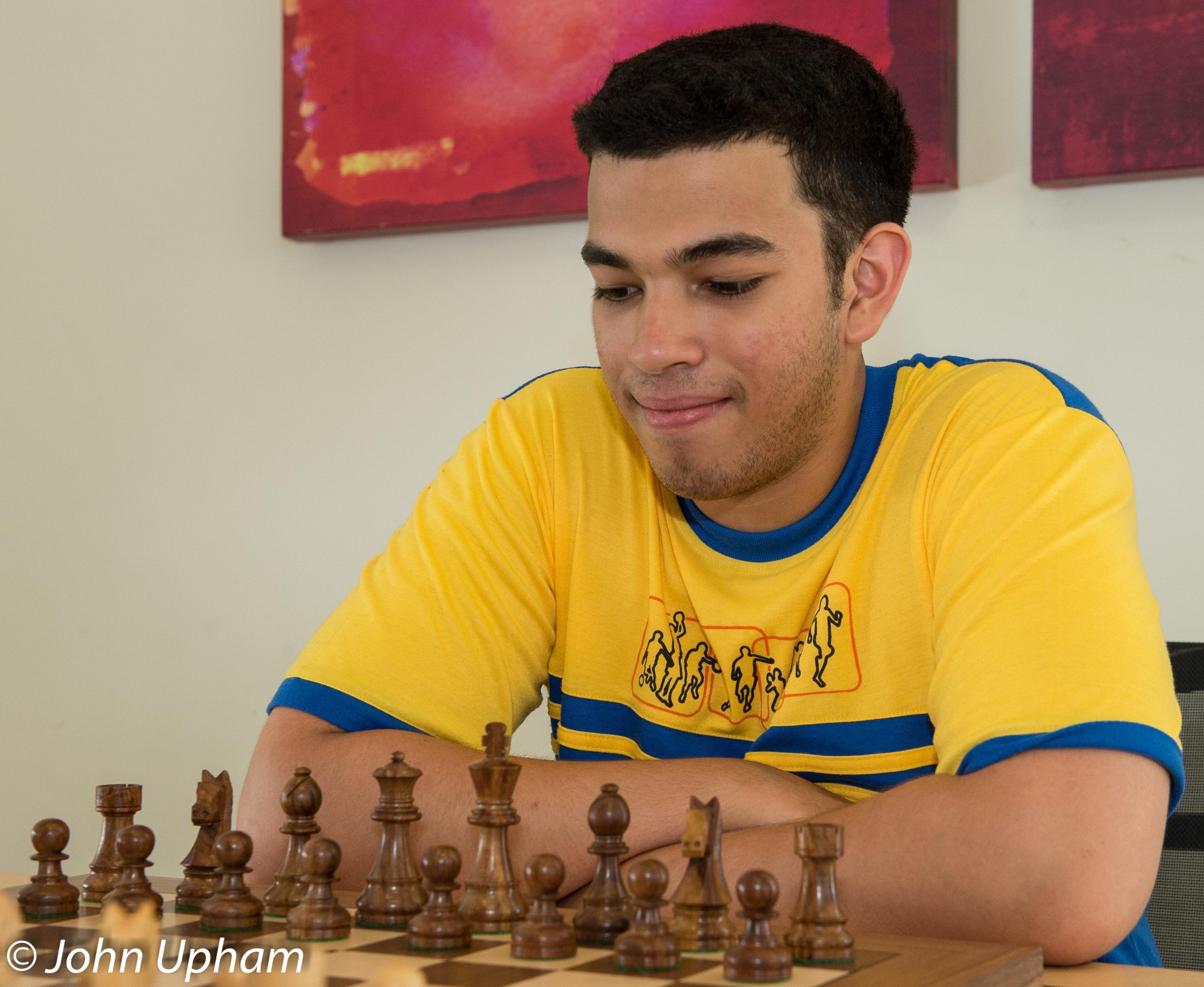
BCN asked Daniel for three of his favourite games. The first one is this Polish Defence game from 2015 played at the Visma Arena in Vaxjo, Sweden. First we have the crosstable showing that Daniel earnt his second GM norm from this event.
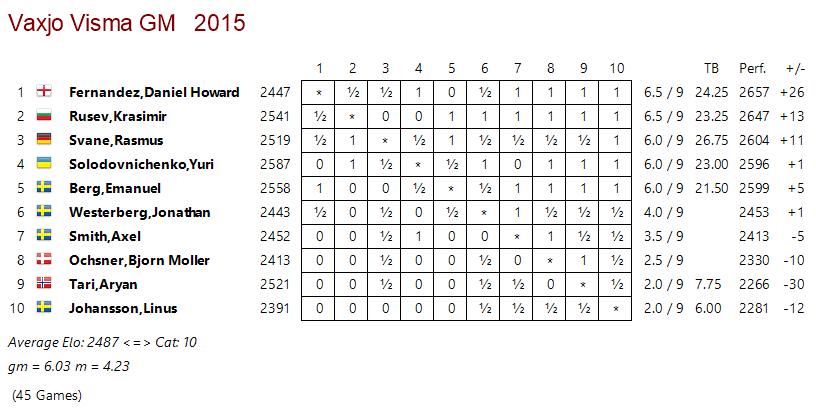
and here is the game:
and during the 2015/15 4NCL season Daniel obtained his final GM norm playing for Wood Green.
In March 2015 he made his first of three Varsity match appearences for Cambridge re-uniting with Danielle Ho and Howard Chiu (remember those names from earlier?).
Daniel won the 10th Jessie Gilbert Memorial in 2017:
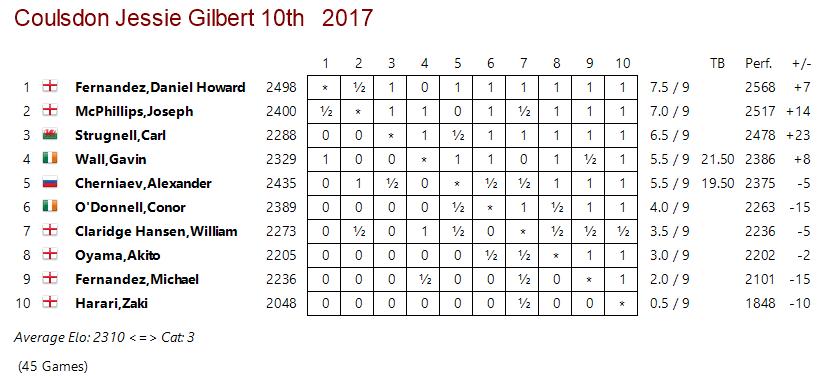
and also in 2017 Daniel was awarded the Grandmaster title at the 88th FIDE Congress 2017, 7-15 October, Goynuk, Antalya, Turkey.
On March 11th Daniel represented Cambridge in the 135th Varsity Match at the RAC Club in Pall Mall. According to chess24.com ‘IM Daniel Fernandez, playing board 2 for Cambridge, was awarded the Brilliancy Prize by GM Ray Keene in consultation with McShane and Speelman, for his “high-class swindle” after recovering from a bad blunder.’ See here for details.
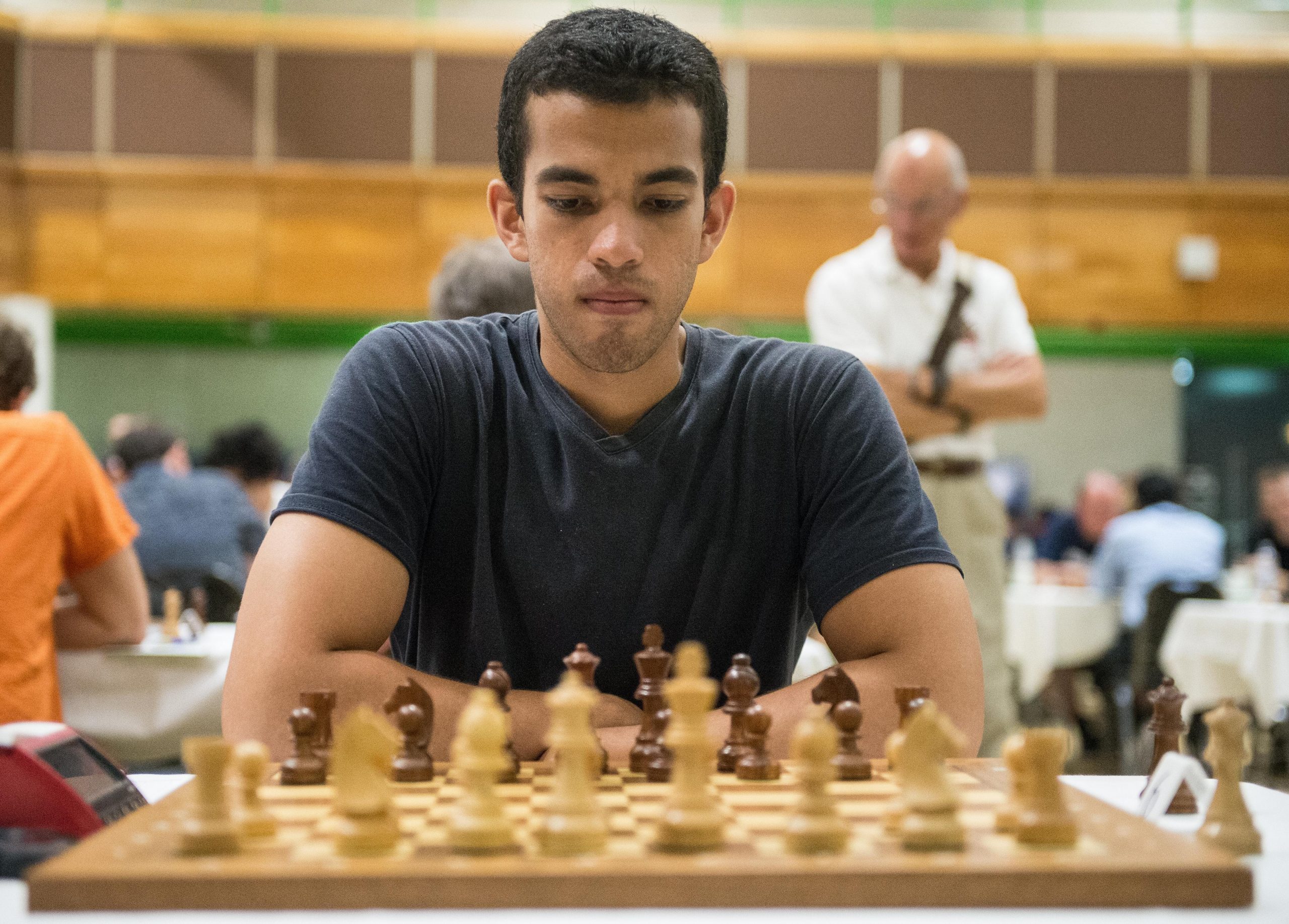
In 2018 Daniel ventured into the world of book writing when Thinker’s Publishing released The Modernized Caro-Kann on September 8th 2018. This was a repertoire book for Black based around the Smyslov Variation :
and was reviewed in this place favourably and quickly established Daniel as a significant author.
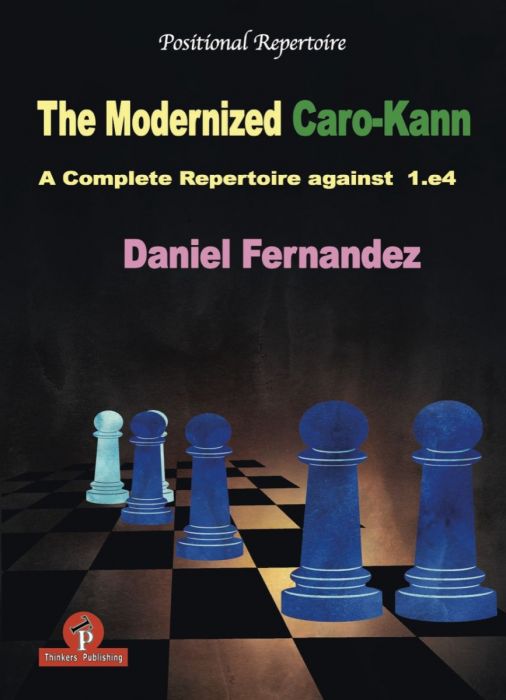
From the rear cover we have:
“GM Daniel Fernandez (born 1995) has been an active and accomplished player for several years. He represented his native Singapore twice at Olympiads (2010 and 2012) before transferring to the English chess federation. There, he won the national classical titles at U-18 and U-21 levels and worked to become a Grandmaster while simultaneously studying at Cambridge. The Caro-Kann was instrumental in his quest for that title. Currently, Daniel is known in the chess scene not only as a solid player, but also as a mentor figure to younger English players, as a producer of well-received commentary and analysis, and as a multilingual chess coach. This is his first book.”
From January 2019 we have this interesting encounter between Gawain Jones and Daniel from the annual 4NCL meeting of Guildford and Wood Green:
With the White pieces Daniel has played a wide range of first moves but the majority move by far is 1.e4. His choice versus the Najdorf is some eclectic : sometime ago 6. Rg1 was the favourite and now 6.a4 is preferred.
Against 1…e5 Daniel offers a main line Ruy Lopez.
What does a Caro-Kann expert play against the Caro-Kann? Nowadays the Two Knights Variation is employed!
As the second player he plays the Sicilian Najdorf as well as the Caro-Kann plus an equal mixture of the Grünfeld and King’s Indian Defences.
In 2019 Daniel was interviewed by Edwin Lam on behalf of ChessBase : fascinating reading!
In the same year Daniel joined IM Adam Taylor’s venture Making Grandmasters.
Our final games is from July 2019 :
Daniel’s most recent publication is The Modernized Modern Defence from Thinker’s Publishing:
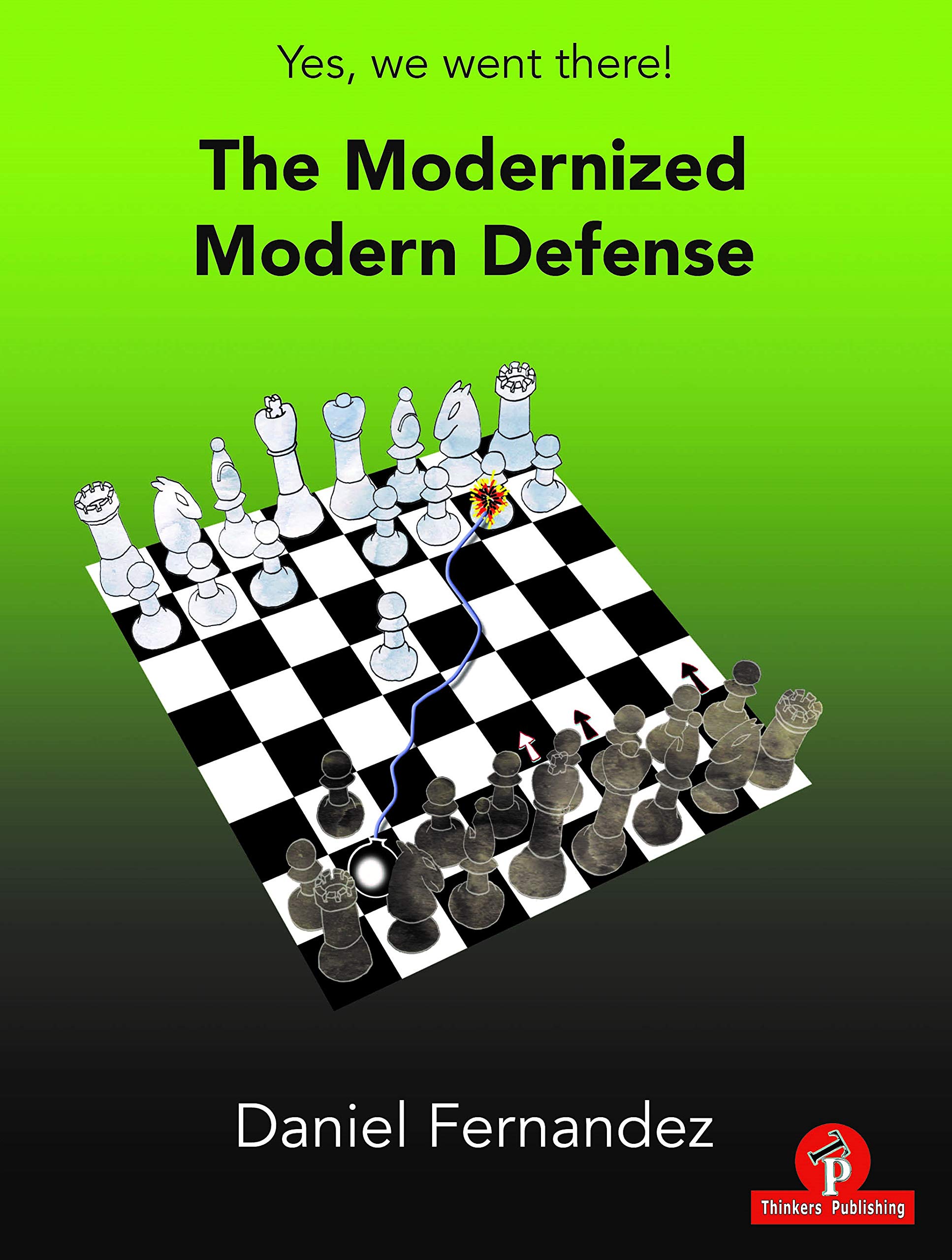
and BCN has been told that Daniel has a book in the pipeline about the Tata Steel 2021 tournament at Wijk aan Zee.
BCN wishes Happy Birthday to GM Daniel Fernandez who at 26 is currently England’s youngest Grandmaster. The previous GM title holder was Jonathan Hawkins in 2014 making two in seven years.
Daniel Howard Fernandez was born in Stockport, Manchester on Sunday, March 5th 1995. “Think Twice” by Celine Dion was top of the UK hit parade.
Daniel started playing chess at the age of seven (after his father taught him the rules) and at this time attended King’s School, Harpenden. His first chess club was Little Heath which became the ECF Small Club of the Year in 2015. They play in the Potter’s Bar area and include IM John Pigott in their membership.
At Little Heath Chess Club Daniel was coached by Mark Uniacke (who worked extensively on the early chess engine HIARCS).
Daniel went up to Queen’s College, Cambridge to read mathematics and left to become a Data Analyst at Mu Sigma Inc. He can speak several languages (including Serbian!) and works as a translator when opportunities arise.
He currently lives in Australia offering coaching and writing chess books (for Thinkers Publishing) and columns for Chessbase. In his spare time (!) Daniel is studying for The Master of Complex Systems degree at The University of Sydney.
Daniel’s first ECF graded game was rapidplay on July 5th 2003 in the SCCU Junior Under-14 Final.
His first standard play game was in August 2003 at the Edinburgh based British Under-8 Championship.

Daniels ECF grading profile demonstrated rapid improvement :

On August 13th 2004 in Scarborough Daniel became British Under-9 Champion sharing the title with Daniel Hunt & Saravanan Sathyanandha.
The Fernandez family relocated to Singapore in August, Daniel attending the Anglo-Chinese School in Singapore. He was swiftly recruited into the Singapore Chess Federation’s (SCF) National Junior Squad. Also in that squad were Danielle Ho and Howard Chiu (remember this for later!).
Barely three weeks after his Scarborough triumph on September 4th 2004 Daniel played his first FIDE rated game in the 5th Asian Under-10 Championship organised by the ASEAN Chess Confederation. His performance in this event was rewarded with a FIDE Master title in 2005. Because he was no longer active in English events the ECF had the unusual scenario of having a ten year old FIDE Master with a published grade of ~120!
In typically modest fashion Daniel confesses that he did not “deserve” the FM title at this time and that it was the consequence of the strong position of the ASEAN and SCF organisations within world chess. At the same event Wesley So gained his FM title in the Under-12 section.

Another interesting consequence of the relocation was that when Daniel returned to England in 2012 his last published grading went from ~ 120 to ~230!
One of the motivations of returning to England was to obtain the necessary entrance requirement to study mathematics at Cambridge. This he did by studying for A-levels at Manchester Grammar School.

Consequently Daniel’s FIDE rating profile also showed a fast pace of development:

Sydney 2009 and Sydney 2010 both provided IM norms with the third one coming from Kuala Lumpar 2010 and with these Daniel became an International Master in 2010 the title being confirmed at the 3rd quarter Presidential Board Meeting 2010, 24-25 July 2010, Tromso in Norway.

He won the Budapest Sarkany Tournament in 2014 as follows:

earning his first GM norm in the process.

BCN asked Daniel for three of his favourite games. The first one is this Polish Defence game from 2015 played at the Visma Arena in Vaxjo, Sweden. First we have the crosstable showing that Daniel earnt his second GM norm from this event.

and here is the game:
and during the 2015/15 4NCL season Daniel obtained his final GM norm playing for Wood Green.
In March 2015 he made his first of three Varsity match appearences for Cambridge re-uniting with Danielle Ho and Howard Chiu (remember those names from earlier?).
Daniel won the 10th Jessie Gilbert Memorial in 2017:

and also in 2017 Daniel was awarded the Grandmaster title at the 88th FIDE Congress 2017, 7-15 October, Goynuk, Antalya, Turkey.
On March 11th Daniel represented Cambridge in the 135th Varsity Match at the RAC Club in Pall Mall. According to chess24.com ‘IM Daniel Fernandez, playing board 2 for Cambridge, was awarded the Brilliancy Prize by GM Ray Keene in consultation with McShane and Speelman, for his “high-class swindle” after recovering from a bad blunder.’ See here for details.

In 2018 Daniel ventured into the world of book writing when Thinker’s Publishing released The Modernized Caro-Kann on September 8th 2018. This was a repertoire book for Black based around the Smyslov Variation :
and was reviewed in this place favourably and quickly established Daniel as a significant author.

From the rear cover we have:
“GM Daniel Fernandez (born 1995) has been an active and accomplished player for several years. He represented his native Singapore twice at Olympiads (2010 and 2012) before transferring to the English chess federation. There, he won the national classical titles at U-18 and U-21 levels and worked to become a Grandmaster while simultaneously studying at Cambridge. The Caro-Kann was instrumental in his quest for that title. Currently, Daniel is known in the chess scene not only as a solid player, but also as a mentor figure to younger English players, as a producer of well-received commentary and analysis, and as a multilingual chess coach. This is his first book.”
From January 2019 we have this interesting encounter between Gawain Jones and Daniel from the annual 4NCL meeting of Guildford and Wood Green:
With the White pieces Daniel has played a wide range of first moves but the majority move by far is 1.e4. His choice versus the Najdorf is some eclectic : sometime ago 6. Rg1 was the favourite and now 6.a4 is preferred.
Against 1…e5 Daniel offers a main line Ruy Lopez.
What does a Caro-Kann expert play against the Caro-Kann? Nowadays the Two Knights Variation is employed!
As the second player he plays the Sicilian Najdorf as well as the Caro-Kann plus an equal mixture of the Grünfeld and King’s Indian Defences.
In 2019 Daniel was interviewed by Edwin Lam on behalf of ChessBase : fascinating reading!
In the same year Daniel joined IM Adam Taylor’s venture Making Grandmasters.
Our final games is from July 2019 :
Daniel’s most recent publication is The Modernized Modern Defence from Thinker’s Publishing:

and BCN has been told that Daniel has a book in the pipeline about the Tata Steel 2021 tournament at Wijk aan Zee.
BCN wishes Happy Birthday to GM Daniel Fernandez who at 26 is currently England’s youngest Grandmaster. The previous GM title holder was Jonathan Hawkins in 2014 making two in seven years.
Daniel Howard Fernandez was born in Stockport, Manchester on Sunday, March 5th 1995. “Think Twice” by Celine Dion was top of the UK hit parade.
Daniel started playing chess at the age of seven (after his father taught him the rules) and at this time attended King’s School, Harpenden. His first chess club was Little Heath which became the ECF Small Club of the Year in 2015. They play in the Potter’s Bar area and include IM John Pigott in their membership.
At Little Heath Chess Club Daniel was coached by Mark Uniacke (who worked extensively on the early chess engine HIARCS).
Daniel went up to Queen’s College, Cambridge to read mathematics and left to become a Data Analyst at Mu Sigma Inc. He can speak several languages (including Serbian!) and works as a translator when opportunities arise.
He currently lives in Australia offering coaching and writing chess books (for Thinkers Publishing) and columns for Chessbase. In his spare time (!) Daniel is studying for The Master of Complex Systems degree at The University of Sydney.
Daniel’s first ECF graded game was rapidplay on July 5th 2003 in the SCCU Junior Under-14 Final.
His first standard play game was in August 2003 at the Edinburgh based British Under-8 Championship.

Daniels ECF grading profile demonstrated rapid improvement :

On August 13th 2004 in Scarborough Daniel became British Under-9 Champion sharing the title with Daniel Hunt & Saravanan Sathyanandha.
The Fernandez family relocated to Singapore in August, Daniel attending the Anglo-Chinese School in Singapore. He was swiftly recruited into the Singapore Chess Federation’s (SCF) National Junior Squad. Also in that squad were Danielle Ho and Howard Chiu (remember this for later!).
Barely three weeks after his Scarborough triumph on September 4th 2004 Daniel played his first FIDE rated game in the 5th Asian Under-10 Championship organised by the ASEAN Chess Confederation. His performance in this event was rewarded with a FIDE Master title in 2005. Because he was no longer active in English events the ECF had the unusual scenario of having a ten year old FIDE Master with a published grade of ~120!
In typically modest fashion Daniel confesses that he did not “deserve” the FM title at this time and that it was the consequence of the strong position of the ASEAN and SCF organisations within world chess. At the same event Wesley So gained his FM title in the Under-12 section.

Another interesting consequence of the relocation was that when Daniel returned to England in 2012 his last published grading went from ~ 120 to ~230!
One of the motivations of returning to England was to obtain the necessary entrance requirement to study mathematics at Cambridge. This he did by studying for A-levels at Manchester Grammar School.

Consequently Daniel’s FIDE rating profile also showed a fast pace of development:

Sydney 2009 and Sydney 2010 both provided IM norms with the third one coming from Kuala Lumpar 2010 and with these Daniel became an International Master in 2010 the title being confirmed at the 3rd quarter Presidential Board Meeting 2010, 24-25 July 2010, Tromso in Norway.

He won the Budapest Sarkany Tournament in 2014 as follows:

earning his first GM norm in the process.

BCN asked Daniel for three of his favourite games. The first one is this Polish Defence game from 2015 played at the Visma Arena in Vaxjo, Sweden. First we have the crosstable showing that Daniel earnt his second GM norm from this event.

and here is the game:
and during the 2015/15 4NCL season Daniel obtained his final GM norm playing for Wood Green.
In March 2015 he made his first of three Varsity match appearences for Cambridge re-uniting with Danielle Ho and Howard Chiu (remember those names from earlier?).
Daniel won the 10th Jessie Gilbert Memorial in 2017:

and also in 2017 Daniel was awarded the Grandmaster title at the 88th FIDE Congress 2017, 7-15 October, Goynuk, Antalya, Turkey.
On March 11th Daniel represented Cambridge in the 135th Varsity Match at the RAC Club in Pall Mall. According to chess24.com ‘IM Daniel Fernandez, playing board 2 for Cambridge, was awarded the Brilliancy Prize by GM Ray Keene in consultation with McShane and Speelman, for his “high-class swindle” after recovering from a bad blunder.’ See here for details.

In 2018 Daniel ventured into the world of book writing when Thinker’s Publishing released The Modernized Caro-Kann on September 8th 2018. This was a repertoire book for Black based around the Smyslov Variation :
and was reviewed in this place favourably and quickly established Daniel as a significant author.

From the rear cover we have:
“GM Daniel Fernandez (born 1995) has been an active and accomplished player for several years. He represented his native Singapore twice at Olympiads (2010 and 2012) before transferring to the English chess federation. There, he won the national classical titles at U-18 and U-21 levels and worked to become a Grandmaster while simultaneously studying at Cambridge. The Caro-Kann was instrumental in his quest for that title. Currently, Daniel is known in the chess scene not only as a solid player, but also as a mentor figure to younger English players, as a producer of well-received commentary and analysis, and as a multilingual chess coach. This is his first book.”
From January 2019 we have this interesting encounter between Gawain Jones and Daniel from the annual 4NCL meeting of Guildford and Wood Green:
With the White pieces Daniel has played a wide range of first moves but the majority move by far is 1.e4. His choice versus the Najdorf is some eclectic : sometime ago 6. Rg1 was the favourite and now 6.a4 is preferred.
Against 1…e5 Daniel offers a main line Ruy Lopez.
What does a Caro-Kann expert play against the Caro-Kann? Nowadays the Two Knights Variation is employed!
As the second player he plays the Sicilian Najdorf as well as the Caro-Kann plus an equal mixture of the Grünfeld and King’s Indian Defences.
In 2019 Daniel was interviewed by Edwin Lam on behalf of ChessBase : fascinating reading!
In the same year Daniel joined IM Adam Taylor’s venture Making Grandmasters.
Our final games is from July 2019 :
Daniel’s most recent publication is The Modernized Modern Defence from Thinker’s Publishing:

and BCN has been told that Daniel has a book in the pipeline about the Tata Steel 2021 tournament at Wijk aan Zee.